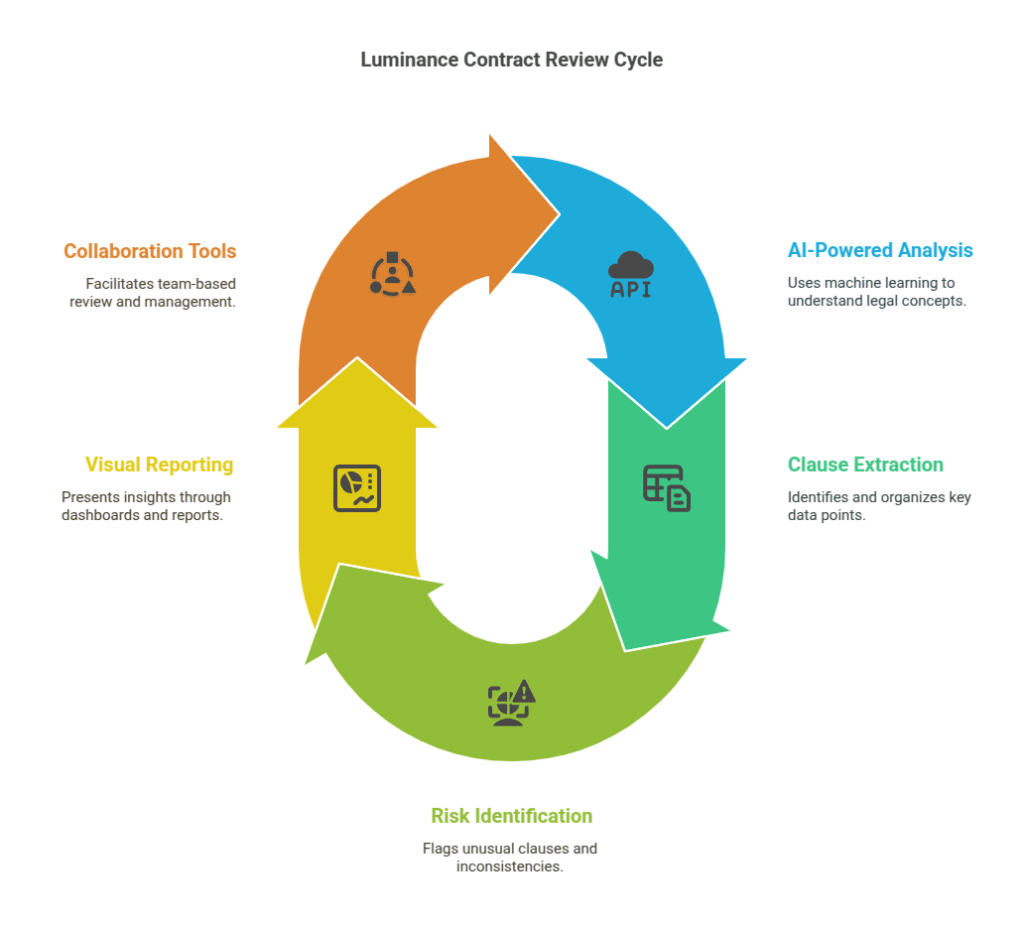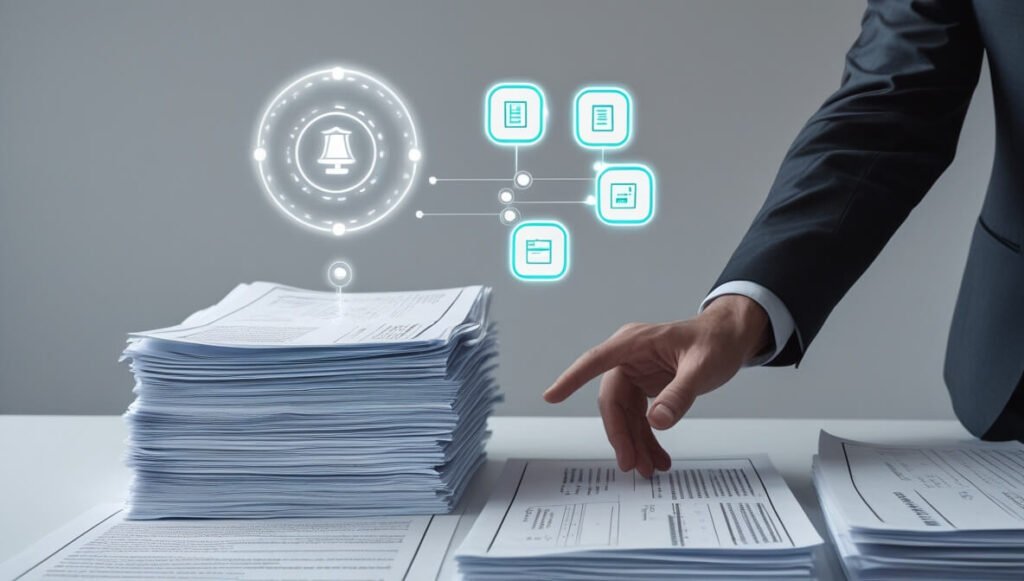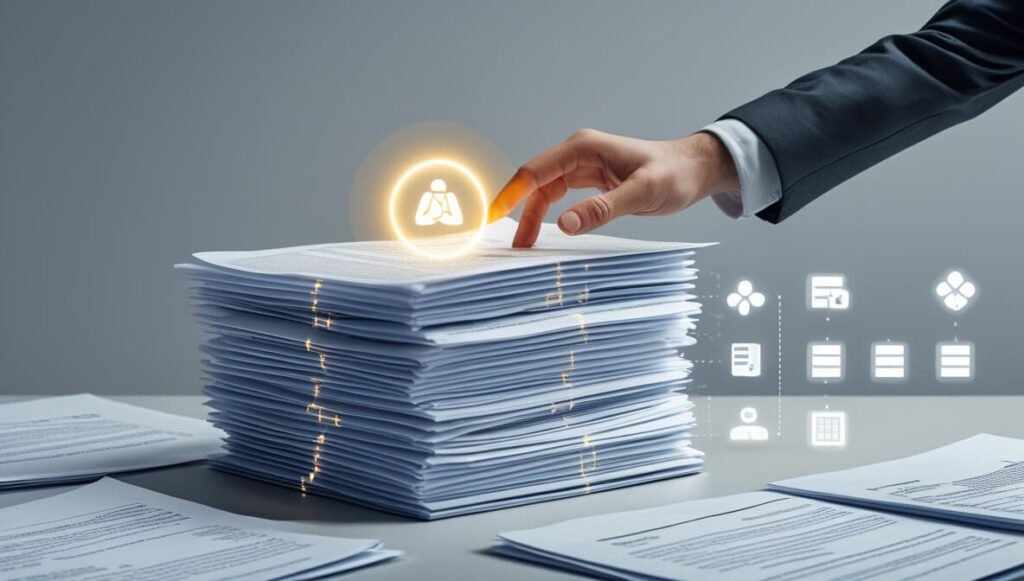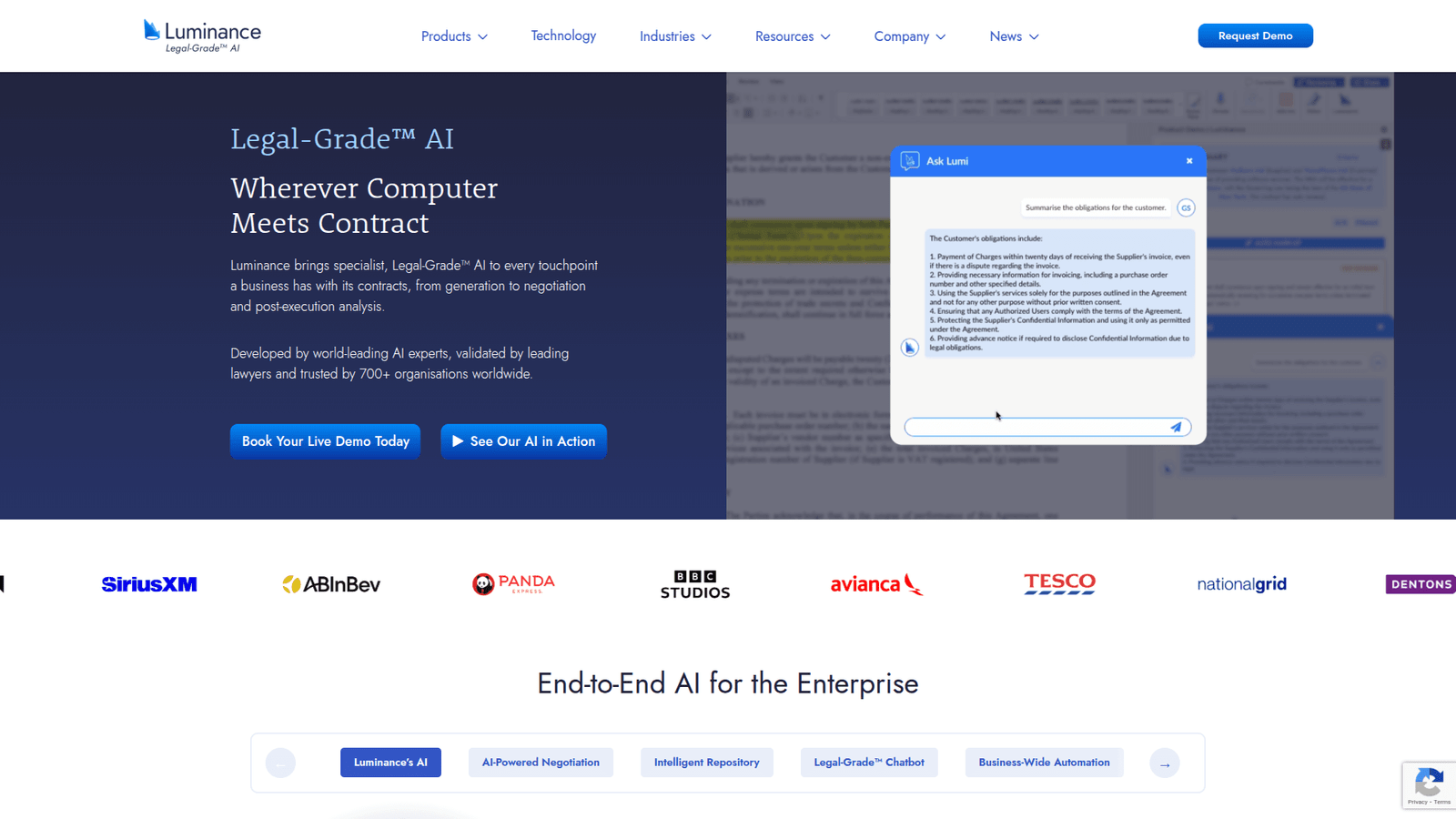Luminance uses AI for Contract Review and Analysis, saving Legal and Finance pros massive time and boosting accuracy. Stop wasting hours. See how it works now.
The Real Reason Pros in Legal and Finance Use Luminance
Alright, let’s talk about AI.
It’s everywhere, right?
Especially in industries you might not expect.
Like Legal and Finance.
Manual work. Hours wasted.
That used to be the name of the game.
Especially when it came to Contract Review and Analysis.
Hundreds, maybe thousands, of pages.
Trying to spot that one crucial clause.
Or find that hidden risk.
It was painful. Slow. Expensive.
But things are changing. Fast.
Tools are popping up.
Tools designed to cut through the noise.
To give you back your time.
And make you better at your job.
One tool is making serious waves.
It’s called Luminance.
And if you work in Legal or Finance, specifically dealing with contracts, you need to know about it.
This ain’t just another piece of software.
It’s a fundamental shift.
A way to get more done.
With less effort.
And frankly, make more money because of it.
Let’s break down why Luminance is becoming the not-so-secret weapon for serious professionals.
And how it handles Contract Review and Analysis like nothing else.
Because honestly?
If you’re still doing this the old way, you’re leaving a lot on the table.
A lot of time. A lot of money. A lot of opportunity.
So, stick around.
We’re going to pull back the curtain on Luminance.
Show you exactly what it does.
Who it’s for.
And why it might be the tool you didn’t know you needed.
It’s time to stop just working hard.
And start working smart.
Table of Contents
- What is Luminance?
- Key Features of Luminance for Contract Review and Analysis
- Benefits of Using Luminance for Legal and Finance
- Pricing & Plans
- Hands-On Experience / Use Cases
- Who Should Use Luminance?
- How to Make Money Using Luminance
- Limitations and Considerations
- Final Thoughts
- Frequently Asked Questions
What is Luminance?
Okay, first things first. What exactly is Luminance?
Think of it as an AI assistant.
Specifically built for reading.
Really, really fast.
And really, really smart.
It’s designed to handle massive amounts of data, especially legal and financial documents.
We’re talking contracts, agreements, leases, financial reports, due diligence materials.
The stuff that makes lawyers and finance pros sigh.
Luminance uses advanced AI, often referred to as machine learning and natural language processing (NLP).
This isn’t just keyword searching.
It actually understands context.
It identifies concepts, clauses, parties, dates, and obligations.
It spots inconsistencies.
It flags risks.
It organises everything it finds.
The core idea?
To take away the soul-crushing, time-consuming manual review work.
The scanning, highlighting, note-taking marathon.
And replace it with something efficient.
Something intelligent.
So, instead of spending days on a single document set, you can get key insights in minutes.
Who is it for?
Law firms, in-house legal departments, financial institutions, corporate M&A teams, compliance officers.
Anyone whose job involves sifting through complex documents.
And needing to understand them quickly and accurately.
Luminance isn’t trying to replace the human.
Not at all.
It’s built to augment the human.
To give you superpowers when dealing with documents.
To handle the heavy lifting of identification and initial analysis.
So you can focus on the strategic stuff.
The advising. The negotiating. The decision-making.
That’s what Luminance is at its core.
A smart tool to make document review less of a nightmare and more of a process.
Especially for complex tasks like Contract Review and Analysis.
Key Features of Luminance for Contract Review and Analysis

- AI-Powered Document Analysis:
This is the engine.
Luminance doesn’t just read words.
It understands legal concepts.
It uses unsupervised machine learning.
This means it starts analysing documents immediately.
Even if it hasn’t seen that specific type of contract before.
It identifies clauses, definitions, parties, dates, and more.
Automatically.
This cuts down initial review time significantly.
You don’t have to train it extensively first.
It learns as it goes.
Spotting patterns and anomalies across large datasets.
It’s like having a hyper-intelligent intern read everything for you.
And highlight the key stuff instantly.
- Clause and Data Extraction:
Finding specific information in a pile of contracts is tough.
Luminance makes it easy.
It can extract hundreds of data points.
Termination clauses, change of control provisions, governing law, renewal dates, payment terms.
You name it.
It pulls this data out and organises it.
Often into a structured format.
Like a dashboard or an exportable spreadsheet.
This is invaluable for due diligence, compliance audits, and contract management.
No more manual data entry from PDFs.
It’s faster and way more accurate.
You get the data you need, presented clearly.
So you can make informed decisions quickly.
- Risk Identification & Anomaly Detection:
This is where Luminance gets powerful for Legal and Finance pros.
It doesn’t just find information.
It compares documents.
It flags clauses that are unusual.
Clauses that deviate from a standard template.
Or clauses that appear inconsistent across a dataset.
This helps you spot potential risks or red flags immediately.
Things a human might miss after hours of reading.
Think non-standard indemnity clauses, unexpected governing law, or missing key provisions.
Luminance highlights these anomalies visually.
So you can focus your attention where it’s needed most.
It prioritises your review efforts.
Ensuring critical risks aren’t overlooked.
- Visualisation and Reporting:
Raw data is useful, but seeing it makes a difference.
Luminance provides visual dashboards.
These show you key insights from your document set.
Graphs showing types of contracts.
Charts highlighting common clauses.
Maps indicating governing jurisdictions.
This gives you a high-level overview.
It helps you understand the entire dataset quickly.
You can see trends.
Identify concentrations of risk.
And report findings clearly to clients or stakeholders.
Customisable reports can be generated.
Sharing the findings from the AI’s analysis.
It makes complex document sets digestible.
And provides actionable insights at a glance.
- Workflow and Collaboration Tools:
Reviewing documents is often a team effort.
Luminance includes features to manage this.
You can assign documents to team members.
Track progress on the review.
Leave comments and notes directly on documents.
It creates a centralised hub for the review project.
Everyone works within the same system.
Ensuring consistency and visibility.
This improves efficiency and reduces errors.
Especially on large-scale projects like M&A due diligence.
It makes the entire Contract Review and Analysis process smoother.
From upload to final report.
Benefits of Using Luminance for Legal and Finance
Why bother with another tool? Especially one involving AI?
Simple. The benefits are huge.
First, speed.
This is the most obvious gain.
Luminance can process documents at superhuman speeds.
What takes a team of lawyers days or weeks?
Luminance does in hours. Or even minutes for initial analysis.
This is critical in time-sensitive deals or investigations.
It means hitting deadlines that were previously impossible.
Or taking on more projects without increasing headcount.
Next, accuracy and consistency.
Humans get tired. They miss things. They interpret clauses differently.
AI doesn’t.
Once trained or configured, Luminance applies the same logic to every document.
It finds what you tell it to find, every single time.
It flags anomalies based on data, not fatigue.
This reduces errors.
Ensures compliance with review protocols.
And gives you confidence in the findings.
Cost savings are massive.
Less time spent on manual review equals lower labour costs.
For law firms, this means more profitable engagements or competitive pricing.
For in-house teams, it means freeing up expensive legal or finance talent.
They can focus on higher-value strategic work.
Instead of being buried in documents.
Think of the billable hours saved. Or the internal cost avoided.
Then there’s better risk management.
Luminance’s anomaly detection is key here.
It proactively identifies potential problems.
Before they become expensive issues.
Spotting a tricky clause early can save millions down the line.
It gives you a clearer picture of the risk landscape within a set of contracts.
Allows for better due diligence.
And stronger negotiating positions.
Finally, improved morale and focus.
Let’s be honest. Manual document review is boring.
It’s tedious. It’s burnout material.
Taking this task off people’s plates is a win.
They can concentrate on using their expertise.
Their judgment. Their strategic thinking.
The stuff they went to school for.
Luminance handles the grunt work.
Allowing the human experts to do what they do best.
These aren’t minor improvements.
They are game-changers for Legal and Finance teams.
They lead to more efficient workflows, higher quality work, and happier professionals.
Pricing & Plans

Alright, the elephant in the room. How much does this cost?
Luminance isn’t typically a self-service tool with a standard price list on their website.
It’s designed for enterprise and professional use.
Pricing is usually tailored.
Based on factors like the size of your organisation.
The volume of documents you need to process.
And the specific features and modules you require.
Think of it less like a Netflix subscription and more like enterprise software.
You’ll need to contact Luminance directly.
Request a demo.
And discuss your specific needs.
They will then provide a custom quote.
Is there a free plan? No, not in the traditional sense.
This is a serious business tool.
But they often offer demos or pilot programmes.
This lets you test the software with your own documents.
To see the value firsthand before committing.
What does a premium plan typically include?
Access to the full AI engine.
Unlimited document uploads and analysis (or a very high limit).
Access to all the key features: data extraction, anomaly detection, visualisations, workflow tools.
Dedicated customer support and training.
Sometimes integrations with existing systems.
How does it compare to alternatives?
The AI contract review space has grown.
Competitors exist, like Kira Systems (now part of Litera), Seal Software (now part of DocuSign), and others.
Luminance often highlights its unsupervised learning approach.
Meaning less upfront training data needed.
And its ability to handle complex, diverse document sets out-of-the-box.
Pricing varies across these platforms too.
Again, custom quotes are standard.
The key isn’t just the sticker price.
It’s the return on investment (ROI).
How much time and money does it save you?
How much does it reduce risk?
Those are the metrics to consider when evaluating the cost.
A tool that costs a significant amount but saves you 10x that in billable hours or avoided losses is cheap.
A tool that costs nothing but doesn’t solve your problem is expensive.
Luminance falls into the category of tools with a clear ROI for teams doing significant Contract Review and Analysis.
You just need to talk to them to figure out your specific investment.
Hands-On Experience / Use Cases
Let’s get real. What does using Luminance actually look like?
Imagine you’re working on a merger or acquisition.
Due diligence is required.
You get handed a data room with thousands of contracts.
Leases, employment agreements, customer contracts, supplier deals.
Your task: review them for change of control clauses, assignment restrictions, termination rights, and liabilities.
Doing this manually? Nightmare.
With Luminance, you upload the documents.
The AI starts processing immediately.
Within hours, maybe less for smaller sets, you get a visual overview.
Luminance shows you how many documents contain specific clause types.
It highlights variations in language.
You can filter by clause, by party, by date.
Need all contracts with a termination for convenience clause?
Click. Done.
Need to see which customer contracts prohibit assignment without consent?
Click. Done.
Luminance flags the unusual ones.
“Hey, this contract has a weirdly short notice period for termination.”
“This supplier agreement has uncapped liability.”
Your team can then jump straight to these flagged documents.
Reviewing only the critical points the AI identified.
Instead of reading every page of every document.
Another use case: Lease abstraction for a real estate portfolio.
Hundreds of leases. Need to find rent amounts, lease terms, renewal options, repair obligations.
Upload to Luminance.
It extracts the key data points into a structured format.
Suddenly, you have a clean database of your lease portfolio.
Ready for financial analysis, portfolio management, or compliance checks.
No more manual data abstraction taking weeks.
Think about regulatory compliance.
A new regulation comes out.
You need to check your existing contracts for compliance.
Does clause X exist? Is it worded correctly?
Luminance can run this check across your entire contract database.
Identifying which contracts need remediation.
Saving countless hours of manual searching.
From a usability standpoint?
Luminance generally gets good marks.
The interface is designed for legal and finance professionals.
It’s visual and intuitive.
While there’s a learning curve with any powerful software, especially AI, Luminance provides training and support.
The results?
Teams report dramatic reductions in review time.
Often 50-80% faster than manual review.
Improved accuracy and fewer missed risks.
Increased capacity to handle more work.
And the ability to offer new, faster services to clients.
It changes the economics of Contract Review and Analysis.
Turning a bottleneck into a streamlined process.
Who Should Use Luminance?

Okay, is this for everyone? Probably not.
If you deal with one contract a month? Luminance is overkill.
If you deal with handfuls? Still probably overkill.
Luminance is for those who face a significant volume of documents.
Who need to review them thoroughly.
And who are currently spending substantial time and resources doing it manually.
So, who fits that description?
Large Law Firms: Especially those with practices in M&A, due diligence, litigation, real estate, or contract management. They handle massive deals requiring rapid, accurate document review.
In-House Legal Departments: Corporate legal teams buried in contracts, compliance documents, and internal policies. They need to manage risk efficiently across the organisation.
Financial Institutions: Banks, investment firms, private equity. They deal with loan agreements, financial contracts, regulatory documents, and portfolio reviews. Speed and accuracy are paramount.
Consulting Firms: Advisory firms involved in M&A, compliance, or operational efficiency projects often need to review client contracts as part of their work.
Corporate M&A Teams: Business development teams directly involved in acquisitions need to quickly assess the contractual landscape of target companies.
Compliance Officers: Anyone responsible for ensuring contracts comply with changing regulations (GDPR, etc.) or internal policies.
Businesses with Large Contract Portfolios: Any company that manages hundreds or thousands of customer, vendor, or employee contracts and needs to extract data, monitor terms, or manage risk.
Think about the scale.
If your team is regularly reviewing hundreds or thousands of pages of documents for specific information or risks, Luminance is built for you.
If the cost of missing a critical clause is high (financially or reputationally), Luminance provides a safety net.
If you’re losing deals or falling behind competitors because your review process is too slow, Luminance can accelerate things dramatically.
It’s for professionals who see Contract Review and Analysis not just as a task, but as a bottleneck to faster, better business outcomes.
It’s an investment in efficiency, accuracy, and capacity.
If those things matter to your bottom line and your sanity, then you should look at Luminance.
How to Make Money Using Luminance
Okay, this is where it gets interesting.
Beyond just saving costs internally, how can using Luminance actually make you or your business more money?
It comes down to speed, capacity, and offering new services.
- Offer Premium, Faster Review Services:
For law firms or consulting firms, this is direct.
You can now offer clients incredibly fast contract review.
“We can review your 10,000 documents for X in 48 hours.”
This is a huge selling point in time-sensitive deals.
You can charge a premium for this speed and efficiency.
While your costs are lower due to the AI.
Higher margin, faster turnaround. Win-win.
Example: A law firm uses Luminance for M&A due diligence. They complete the review in half the time of competitors. They secure more M&A deals as a result.
- Handle Larger Volumes of Work:
With Luminance, your team’s capacity for document review skyrockets.
One person using Luminance can potentially do the work of several people reviewing manually.
This means you can take on more projects.
More clients. More deals.
Without needing to hire proportionally more staff.
It’s direct revenue growth enabled by technology.
Example: An in-house legal team uses Luminance to manage thousands of supplier contracts. This frees up lawyers to work on strategic initiatives, contributing directly to business growth.
- Develop New, Specialised Services:
Luminance allows for deep analysis across large document sets.
This opens up new service lines.
Like large-scale compliance audits based on contract terms.
Or creating comprehensive contract databases and reports for clients.
You can offer contract portfolio risk assessments.
Or data migration services for contract management systems.
These are valuable services that are impractical or too expensive to offer without powerful AI like Luminance.
Example: A consultancy uses Luminance to offer a “Contract Health Check” service, analysing clients’ contracts for compliance with new data privacy laws and charging for the assessment and remediation plan.
Consider this: Legal and Finance professionals charge a lot per hour.
Every hour saved on Contract Review and Analysis is an hour that can be spent on billable strategic work.
Or an hour that doesn’t need to be billed, making you more competitive.
Luminance isn’t just a cost centre.
It’s a profit centre.
It enables you to deliver faster, better, and more varied services.
Ultimately attracting more clients and increasing revenue per professional.
Limitations and Considerations
No tool is perfect. Luminance is powerful, but it’s not magic.
Here are some things to keep in mind:
Accuracy isn’t 100% out of the box, every time.
It’s AI. It learns and gets better.
But you still need human oversight.
The AI flags things. It extracts data.
But a human lawyer or finance pro must review the findings.
Validate the extracted data.
Interpret the nuances that AI might miss in complex or highly unusual clauses.
It’s a tool to augment your skills, not replace your brain.
Requires clean data inputs.
The better the quality of the documents you upload, the better the results.
Poor scans, inconsistent formatting, or highly corrupted files can impact the AI’s performance.
Getting documents into a readable format is sometimes an initial step.
Implementation and training take time.
While Luminance boasts quick deployment, integrating any new enterprise software requires effort.
Users need to be trained on how to use the platform effectively.
How to set up reviews.
How to interpret the AI’s findings.
This isn’t like downloading a phone app.
It’s a professional tool that requires proper onboarding.
Cost can be a barrier for smaller teams.
As discussed, this isn’t cheap software.
It’s an investment with a strong ROI for high-volume users.
But for very small businesses or individuals, the cost might be prohibitive.
The value scales with the volume of documents processed.
It’s best for specific tasks.
Luminance excels at structured, document-based review.
It’s not a general-purpose AI for all legal or finance tasks.
It won’t write contracts from scratch (though some tools are moving that way).
Its strength is understanding and analysing existing documents at scale.
Knowing these limitations helps set realistic expectations.
Luminance is a powerful solution for the problem of high-volume, manual document review.
But it’s a tool within a larger workflow.
It still needs smart humans at the helm.
Final Thoughts
Look, the world of Legal and Finance is changing.
AI is no longer a futuristic concept.
It’s here. And tools like Luminance are proving its value today.
Especially in areas like Contract Review and Analysis.
If you’re still slogging through documents page by page…
You’re working harder, not smarter.
You’re wasting valuable time.
Time you could spend on strategic work.
Building client relationships.
Closing deals.
Making actual money.
Luminance tackles the grunt work.
It gives you speed, accuracy, and consistency that manual review can’t match.
It helps you find critical information and risks faster.
It frees up your most valuable resource: your skilled professionals.
Yes, it’s an investment.
But the potential ROI in saved hours, reduced risk, and increased capacity is significant.
For any firm, department, or team dealing with a substantial volume of complex documents, Luminance is worth serious consideration.
It’s not just about using AI.
It’s about using AI to solve a real, painful business problem.
To become more efficient.
More competitive.
More profitable.
Don’t get left behind doing things the old way.
Explore how Luminance can transform your contract review process.
It might be the smartest move you make this year.
Visit the official Luminance website
Frequently Asked Questions
1. What is Luminance used for?
Luminance is primarily used for AI-powered document review and analysis.
It helps legal and finance professionals quickly understand and extract key information from large volumes of documents.
Its main application is in tasks like Contract Review and Analysis, due diligence, compliance, and lease abstraction.
2. Is Luminance free?
No, Luminance is not a free tool.
It’s an enterprise-level software solution.
Pricing is typically custom and based on the client’s specific needs and scale of use.
They often offer demos or pilot programs.
3. How does Luminance compare to other AI tools?
Luminance competes with other AI-powered contract review platforms like Kira Systems and Seal Software.
A key differentiator Luminance highlights is its unsupervised machine learning approach.
This allows it to analyse documents effectively with less upfront training data.
Each tool has different strengths and ideal use cases.
4. Can beginners use Luminance?
Luminance is a professional tool designed for legal and finance experts.
While the interface is designed to be intuitive, there is a learning curve associated with any powerful software.
Luminance provides training and support to help users get up to speed.
It’s built for professionals, not casual users.
5. Does the content created by Luminance meet quality and optimization standards?
Luminance doesn’t “create” content like marketing copy.
It analyses existing documents and extracts data or insights.
The quality of its analysis depends on the input documents and the specific review criteria set by the user.
Its purpose is accuracy and efficiency in document review, not content generation for optimisation standards.
6. Can I make money with Luminance?
Absolutely. By significantly speeding up and improving the accuracy of Contract Review and Analysis, Luminance allows firms and teams to handle more work, offer premium faster services, and develop new data-driven consulting services.
This increased capacity and ability to deliver higher value translates directly into potential revenue growth.






